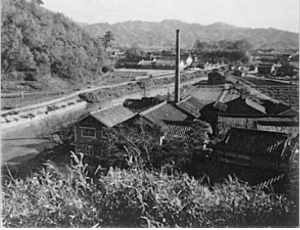The site of SAKAMOTO Seiichirofs house
 This was the house built by Seiichiro separately from the head familyfs
house. The main house was located on the inner area of the premises, with
the room detached from the main house as well as the storehouse on the
front area. To the south of the main house was the glue factory with a
high chimney.
This was the house built by Seiichiro separately from the head familyfs
house. The main house was located on the inner area of the premises, with
the room detached from the main house as well as the storehouse on the
front area. To the south of the main house was the glue factory with a
high chimney.An enormous amount of the materials, which are preserved in the Suiheisha History Museum, were discovered from the housefs storehouse, making it possible to know different aspects of SAKAMOTO Seiichiro. He has been seen as ga son of the owner of a glue factory and the exchequer of the Suiheisha, who always pulled the strings behind the scenes in the Suiheisha movementh. According to the SAKAMOTO materials, however, he always worked to prevent breakups at the fourth, seventh and tenth national congresses of the Zenkoku Suiheisha, when the organization was at risk of disunion due to internal conflicts. He can be regarded as a substantial leader and organizer of the Suiheisha movement.
In addition, historians have focused on how they should appreciate the anarchists and the Bolshevists in the appraisal of the Suiheisha movement, almost disregarding SAKAMOTO, YONEDA and other social democrats. Without them, however, the Zenkoku Suiheisha would not have been able to organize their national congresses sixteen times. SAKAMOTO left confrontations between the two factions out of account, saying that they were gultra short-tempered bugsh, and continued to emphasize the importance of gfraternal unityh.
He also succeeded in the development of thin gelatin sheets for photographic films, contributing to the domestic production of photographic films. While glass dry plate negatives were used for photographic purposes at the time, celluloid roll films were developed in Europe and Japan started to import them through British, French and German residents in Qingdao and Shanghai in China, which were the territory of the United Kingdom. However, the trade discontinued because of the policy of Japan to pursue aggression into the Korean Peninsula and the China mainland, which made it difficult to import films. Japan desperately needed celluloid roll films, which were more durable and easier to carry than glass dry plates, in order to conduct preliminary surveys in the target areas of aggression and to enhance war sentiment and the glory of the nation by filming victory scenes. So Dainippon Celluloid Co., Ltd., (the predecessor of Fujifilm) and other companies attempted in haste to develop equivalent products but in vain. In 1937, however, SAKAMOTO himself succeeded in the development of such films at the Kawakami Factory of Sakamoto Industrial Works, which he had run in Kawakami Village, Minamisaku County, Nagano Prefecture. In 1939, SAKAMOTOfs factory and manufacturing method were sold to the Kawakami Factory, which was located in the same village, of Tokyo-based Nippon Chemical Works Co., Ltd. Then Fuji Photo Film Co., Ltd., invested in, partnered with and took part in the management of the company, which was subsequently absorbed by Fuji Photo Film. The Kawakami Factory was reestablished as the site of the latter.
SAKAMOTO published a lot of books on glue and gelatin as well. In summary, he was multifaceted personality, being an excellent organizer in the forefront of the Suiheisha movement as well as a competent chemist and author at the same time.
[Back]
[Home]